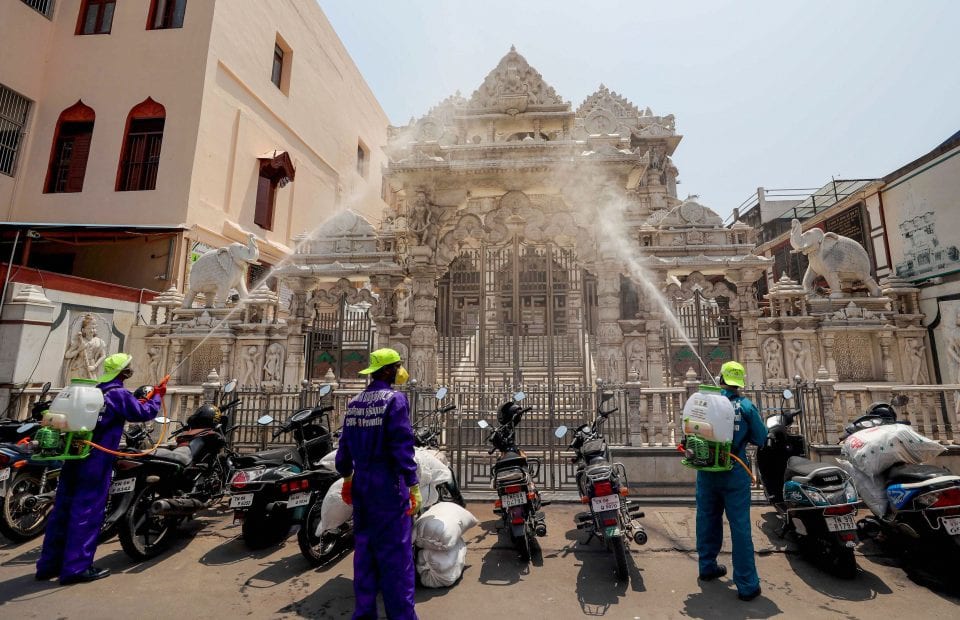
COVID-19: Drones, mist cannons, creativity speed up disinfection in TN
Authorities in Tamil Nadu, as part of efforts to prevent the spread of COVID-19, use drones, mist cannons, and have come up with other innovative ideas like using catchy taglines to urge people to walk through the disinfectant tunnels when they visit market places.

Authorities in Tamil Nadu, as part of efforts to prevent the spread of COVID-19, use drones, mist cannons, and have come up with other innovative ideas like using catchy taglines to urge people to walk through the disinfectant tunnels when they visit market places.
In Chennai, which has 172 coronavirus positive cases — the district with the highest number in Tamil Nadu — Greater Chennai Corporation officials use drones in densely-populated neighbourhoods like Thiru-Vi-Ka Nagar as children watch the drive with curiosity from their balconies.
“We are using drones in densely-populated areas and the results are good,” an official said adding about six litres of disinfectant liquid was being used for a single trip.
Mist cannons, which are huge blowers, are mounted on trucks that go around spraying disinfectant fumes in downtown areas and in other containment zones in addition to localities of positive patients.
Butterfly sprinklers — that swing up and down like a butterfly’s wings when dispensing the disinfectant fog — placed on the rear of tractors are also being used by the civic body for clean-up work.
Related news | The Federal Impact: TN asks Collectors not to set up disinfectant tunnels
Anti-bacterial fluid containers connected to jet spray guns are taken in light cargo vehicles to easily navigate narrow alleys in city neighbourhoods.
Germicide and bleaching powder was sprinkled on all roads, alleys, and intersections. Volunteers wearing artistically-designed coronavirus crowns are also helping authorities in several areas to drive home the message of social distancing, personal hygiene, and the need to stay indoors.
Officials came up with a fresh idea to spur people to use the disinfectant tunnels set up in six locations in Tiruvannamalai district. “Come inside (the tunnel), are you coming in or shall I (coronavirus) come (infect you)?” the tagline in Tamil, embossed on the tunnels facade asks.
In Tamil, the slogan is more punchy as it has striking colloquial words used everyday to convey the message (Ulley vaaaa… nee varriyaa… illa naan varatta!).
The sprawling Aarani Fort and Isanya grounds in Tiruvannamalai district that house the temporary vegetable markets are among the places where the disinfectant tunnels have been set up.
People visiting the markets cannot miss the tunnels as they are placed prominently. Public are asked to walk through the passage fitted with sprayers and sprinklers before and after their purchase.
Related news | COVID-19 disinfectant tunnels may harm humans more than virus
Cheyyaru and Vandavasi bus termini in the district also have the disinfectant walk-through arrangement.
However, the idea of disinfectant tunnels have received mixed responses since the prime ingredient in these disinfectants, sodium hypochlorite, could be harmful to humans in used excessively.
It is also said that these disinfectants have not been proven to kill the virus, and that it may result in irritation to the skin and eyes if sprayed too much.
Soon after, the Tamil Nadu government suggested districts not to set up such tunnels and look for alternative disinfection methods.
A few of the districts that have already set up these tunnels responded that they would remove them.
“We didn’t know that it [tunnel] would not be effective and would harm the people. But, now as we have got the instructions, we will remove the existing tunnels in our district,” said one of the district Collectors who wished to remain anonymous.
Tamil Nadu has a total of 911 coronavirus cases and Tiruvannamalai district 10 as on April 10 evening.
(With inputs from agencies)


